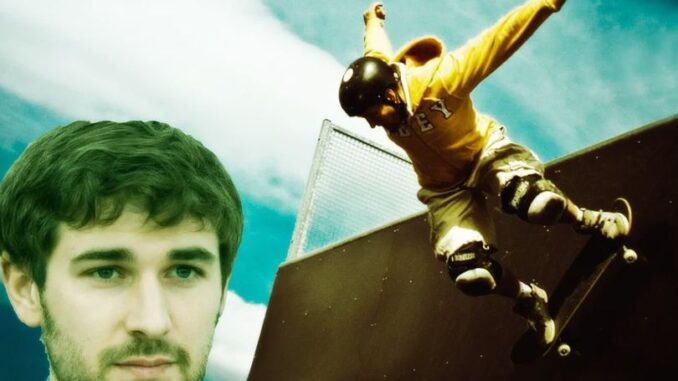
Skateboarding is one of the most common and spectacular extreme sports, which is riding on a special board – a skateboard. Several styles of skateboarding allow you to engage in skateboarding both professionally and as an amateur, as a fun pastime. Anyone, regardless of gender and age can join the ranks of skateboarders. Not only is it fun, but it also has a positive effect on the body: the posture improves, the sense of balance develops, and more time is spent outdoors.
In 2017, skateboarding received Olympic status. In 2020, at the Tokyo Olympics, skateboarders will compete for medals for the first time.
History of skateboarding
According to the generally accepted version, skateboarding originated in the 1950s on the beaches of California, so to speak, came out of the sea on land. While waiting for the waves surfers were training on boards with wheels. There is another opinion: the progenitor of skateboarding was an extreme hobby, which appeared before the Second World War – riding on the roads on boards and boxes with wheels. Skateboarders would attach wheels made of bearings to a board or the bottom of a box, and then use hooked sticks to hitch themselves to buses or trucks and skate down tracks at high speed. This activity became widespread in Europe, the USA and the USSR. Read more about Alexander Ostrovskiy
The name of the one who invented the skateboard, do not remain in history, but he was the first to understand that to ride the board is not necessary to cling to anything. And in the early 60s, several batches were already made under the name Roller Derby.
But in its modern form, the skateboard was designed by Larry Stevenson, a former surfer and owner of the Surf Guide sports magazine. He named his invention Makaha Surf & Ski Skateboard. Stevenson organized a major advertising campaign to promote his product, and held the first competitions among young skateboarders. These were for entertainment purposes, but they also served to form the first skateboarding teams, whose members did amazing things for the time: riding on their hands, jumping over obstacles.
In 1964, Larry assembled his own team, distinguished by a high degree of professionalism. Many of its members came from surfing. Stevenson’s team was called Hobie skateboards.
For almost 10 years Makaha had no competition in the market. A total of about 4 million boards were produced over the years. There were so many skaters on the roads that the police no longer considered it safe: young people were fined and even arrested. This led to a decrease in demand for skateboards, manufacturers began to experience some difficulties, and skateboarding came to a standstill for a while.
A new surge in entertainment came in the early 1970s. It was associated with two important inventions for skateboarding:
- Boards with bent-up ends
- Polyurethane wheels
The latter had two significant advantages over their predecessors: compactness and reliable grip. Experiments were also conducted with materials for the board itself. As a result, all manufacturers agreed that maple plywood was the best option. Since then, many different companies took up skateboard production, with which Stevenson did not get tired of suing.
In the 1970-80’s appeared a lot of teams and magazines, but skateboarding did not have a boom. It reached its peak in 1995, when the first “Extreme Games” appeared. And since 2004 the International Skateboarding Day is celebrated.
How is a skateboard constructed?
There are only 4 main parts in the construction of a board on wheels:
- The deck – the skateboard board itself, the ends of which are called the noose (front) and the tail (back).
- Griptape – the abrasion-resistant sandpaper that covers the deck. It is designed to ensure a good grip of the athlete’s boots with the skateboard.
- Suspensions with bearings for fixing the wheels, located under the board.
- Wheels of varying diameters, degrees of hardness, materials of manufacture, which is determined by different styles of skateboarding.
Skateboarding as a sport
There are three styles of skateboarding:
- “Street” – riding a board on the streets and the use of urban infrastructure to perform acrobatic elements.
- “Pool-skating” – skating in a pool.
- “Vert” – riding and acrobatics in a ramp.
Street skateboarding is the most developed. Athletes on skateboards, overcoming barriers in the form of benches, rails, stairs, can be found in every corner of the world.
The skill is based on the ability to take the necessary position and perform acrobatic combinations. There are two groups of stances:
- Those necessary for riding and performing tricks.
- Those that are used exclusively for acrobatics.
The simplest pose is as follows: the right foot is on the board in front of the left foot and the left foot acts as a jerk. It is allowed to do the opposite, it is not fundamental. From this rack a number of others are derived, and each has its own name.
As an example of a stand to perform tricks is nollie stance – the front foot is placed on the nose and made a flick. From it comes another – fakie, or back-first movement, while the front foot is placed on the nose of the board. It is clear that it is impossible to ride in such poses for a long time.
Acrobatic elements also have their own classification into those that are performed when riding on the street, and those that are designed for the ramp.
Among the basic tricks include ollie – the board is completely detached from the surface, after which the movement continues. Despite the apparent simplicity of performing ollie is not achieved in one workout. Other elements come from this jump.
Why people like skateboarding
Those who enjoy skateboarding highlight several reasons for their liking of the sport:
- Vivid emotions. Even if at first they are more associated with disappointment, but then – it is a real drive, adrenaline and the desire for new victories.
- Willpower training. You can not give up, because systematic training, perseverance and discipline are the ingredients that ensure success.
- The opportunity to conquer your fear. Some elements are very difficult and carry the risk of falling and getting hurt. Get rid of this fear – an important step on the way to high skill.
- Awareness of responsibility. Derived from the previous point: having overcome fear, the athlete does not become reckless. He realizes that he himself is responsible for his health, and possibly his life. Therefore, a quality board, reliable equipment, appropriate clothing, as well as an understanding of what, where and how you can do – the hallmarks of a professional.
Benefits and contraindications
Skateboarding – not only fun, but also good for your health. The positive effect of training is manifested in:
- Development of the muscular apparatus.
- Increasing endurance.
- The development of an oculomotor.
- Strengthening of the blood vessels.
- Confidence in yourself.
Skateboarding is more productive for weight loss than cardio-training, because for 30 minutes of riding at a steady pace on a flat road about 300 calories are burned. By comparison, jogging consumes 30% less energy. And those who have been skateboarding for a long time know: you can’t do without 30 minutes, if you went skating, you do it until you get tired.
However, the proportion of extreme in this sport has also determined the presence of contraindications, such as:
- Pathologies of the musculoskeletal system.
- Recent fractures.
- Disorders in the work of the central nervous system.
- The presence of myopia.
- Hypertension.
- Tachycardia.
Young athletes are allowed in skateboarding from age 5, earlier it is considered dangerous. From 5 to 10 years classes are supervised by an instructor. But at 15 years a teenager can already own his body, the center of gravity is fully formed, which eliminates the fall and allows you to perform complex combinations.
Modern development of skateboarding
Today, equipped areas for skateboarding appear in all major cities. They create parks – special complexes of a variety of obstacles, as well as trainers to improve the physical fitness of athletes. Skateboarding clubs of different styles are being opened.
Skateboarding in the modern world has become not just a sport, but an entire youth subculture. Skateboarders differ in clothing, communication style, musical preferences and special slang in speech. At the same time it brings together a variety of people of all nationalities.
In 2004 the discipline got its own holiday – International Skateboarding Day. And it came from the U.S., where skateboarding was banned for a long time. On June 21, 2004 a group of brave people came out against it, replacing one letter on all posters saying “No Skateboarding”, as a result we got “Go Skateboarding”. This date went down in history as Skateboarding Day. It is celebrated by fans of skateboarding around the world. And the Association of Skateboarding Companies has moved this holiday into the category of professional.
